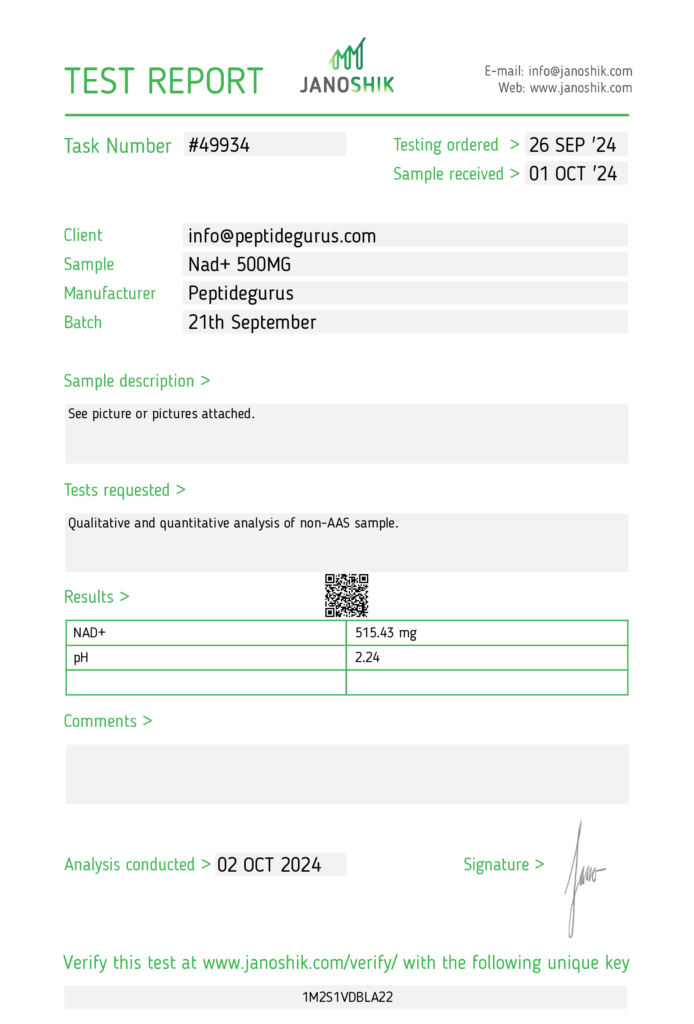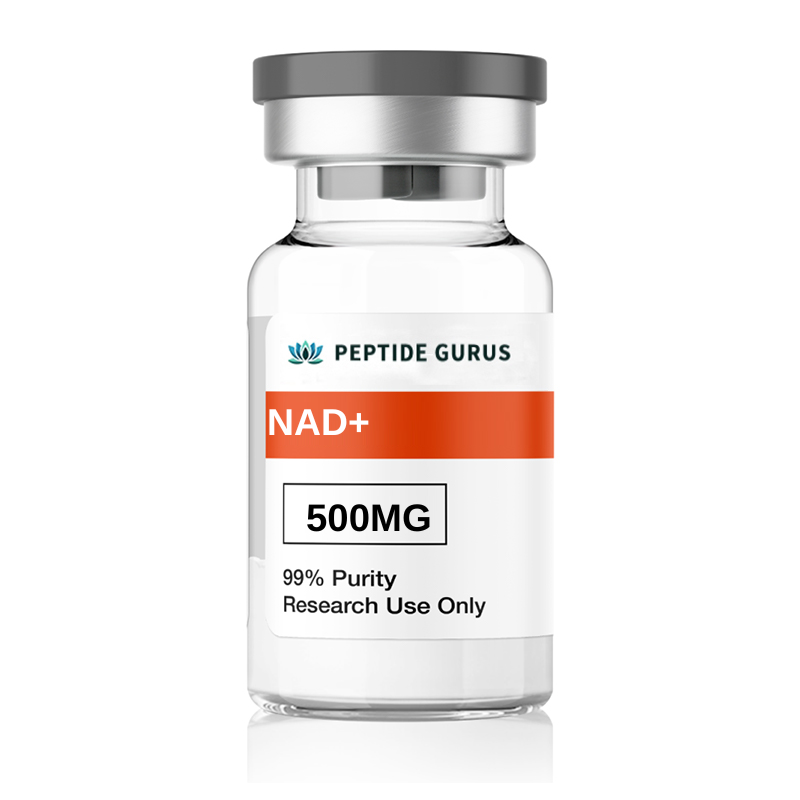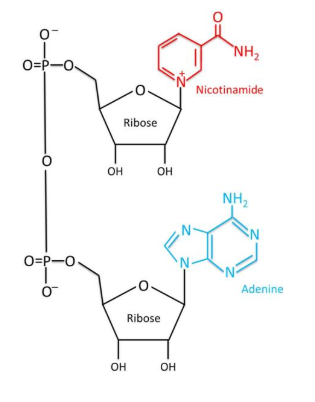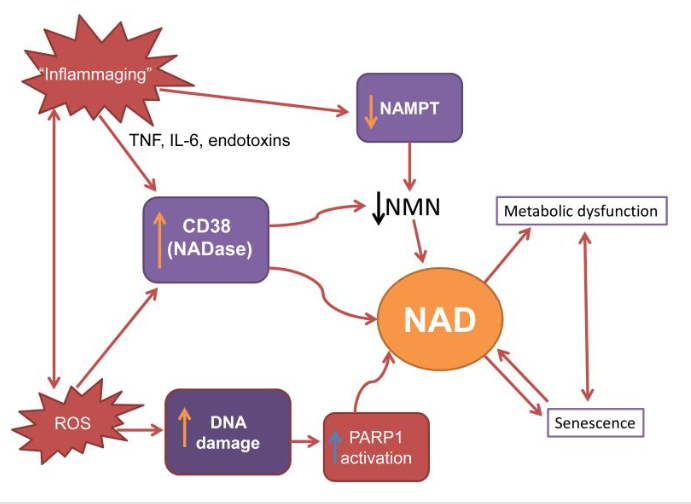




Categories: Peptide Finished product, Peptides and Their Dosages
Free (1) 30 ml Bacteriostatic Water
with qualified orders over $500 USD.
(excludes capsule products, cosmetic peptides, promo codes and shipping)
NAD+ (Nicotinamide adenine dinucleotide) is the oxidized form of NADH and a naturally occurring compound. Research shows that NAD+ may be beneficial in improving muscle function, protecting cells of the nervous system, and generally reducing the effects of aging.
Product Usage: This PRODUCT IS INTENDED AS A RESEARCH CHEMICAL ONLY. This designation allows the use of research chemicals strictly for in vitro testing and laboratory experimentation only. All product information available on this website is for educational purposes only. Bodily introduction of any kind into humans or animals is strictly forbidden by law. This product should only be handled by licensed, qualified professionals. This product is not a drug, food, or cosmetic and may not be misbranded, misused or mislabled as a drug, food or cosmetic.
NAD+, short for nicotinamide adenine dinucleotide, is the oxidized form of NADH. It’s main biological function is to carry electrons from one biochemical reaction to another, acting to shuttle energy within a cell and, in certain conditions, to extracellular locations as well. NAD+ also plays roles in enzyme activation/deactivation, posttranslational modification of proteins, and cell-to-cell communication. As an extracellular signaling molecule, NAD+ has been found to be released from neurons in blood vessels, the bladder, the large intestine, and from certain neurons in the brain.

Sequence: N/A
Molecular Formula: C21H27N7O14P2
Molecular Weight: 663.43 g/mol
PubChem CID: 925
CAS Number: 53-84-9
Synonyms: nicotinamide adenine dinucleotide, beta-NAD, NAD, Endopride
One of the primary results of the standard aging process is a decline in both the quality and activity of mitochondria. Mitochondria are the body’s power plants, producing the energy for everything from neuron firing to digestion and muscle function. A decline in mitochondrial functioning has been associated with normal aging, but is also a factor in a number of age-related disease processes. Research shows that mitochondrial aging contributes to cellular senescence, inflammation, and even changes in stem cell activity that reduce rates of healing and make it harder for the body to recover from injury in old age[5].
According to Nuo Sun of the Heart, Lung, and Blood Institute of the National Institutes of Health, mitochondria cannot simply be viewed as bioenergetics factories, but “rather as platforms for intracellular signaling, regulators of innate immunity and modulators of stem cell activity.” He goes on to explain that “mitochondria can be linked to a wide range of processes associated with aging including senescence, inflammation, as well as the more generalized age-dependent decline in tissue and organ function.” In other words, mitochondria are the lynch pin of cellular aging and understanding how to protect their function is a necessary first step in understanding how to slow, stop, or even reverse the aging process.
New research suggests that at least some of the age-related decline seen in mitochondria can be reversed through dietary supplementation with NAD+. This function of NAD+ was uncovered, or at least made popular in research circles, by David Sinclair of Harvard University. Sinclair is the same researcher who uncovered the anti-aging effects of reservatrol (a component of red wine). In 2013, Sinclair revealed that mitochondria in the muscle of mice could be restored to a more youthful state via injection of a precursor to NAD+[6].
Research completed in 2013 showed that declining levels of NAD+ leads to a pseudohypoxic state within cells. This, in turn, interrupts the normal signaling that takes place between the nucleus, where DNA resides, and the mitochondria. By supplementing old mice with NAD+, mitochondrial function is restored and the communication commences again[7].
At least prat of the reason that NAD+ helps to offset the effects of aging is that it activates SIRT 1 function in the nucleus and prevents the normal age-related decline in expression of this particular gene. SIRT 1 is a gene encoding a protein known as sirtuin 1 (short for NAD-dependent deacetylase sirtuin-1). Sirtuin 1 is an enzyme that plays important roles in regulating proteins involved in cellular metabolism and processes linked to stress, longevity, and inflammation[8].

Another link between aging and NAD+ can be seen in skeletal muscle tissue. In mouse models, age-related muscle decline occurs in two steps. In the first step, oxidative phosphorylation (the process mitochondria use to produce energy) declines because of reduced expression of mitochondrial genes (mitochondria contain their own DNA). In the second step, genes regulating oxidative phosphorylation begin to malfunction in both the mitochondria and nucleus. Phase 1 is reversible. If NAD+ is administered, mice in these studies show improved mitochondrial function and do not progress to step 2. If, however, the mice are allowed to progress to stage 2 without intervention, then NAD+ cannot rescue them[9]. This evidence suggests that intervention in mitochondrial aging is possible using NAD+, but that waiting too long results in refractory dysfunction. It is the best argument yet that early supplementation with NAD+ is critical to fighting off aging in the long term.
Research shows that exercise training actually has the same effects on aging mitochondria as NAD+ supplementation does. It appears that, in both cases, intervention helps to prevent changes in peroxisome proliferator-activated receptor gamma co-activator 1-alpha (PGC-1-alpha) signaling that lead to mitochondrial dysfunction[10].
Research in mouse models of skeletal muscle aging suggests that exercise training helps to maintain muscle oxidative capacity over a lifetime. At least part of the reason that this works is that exercise increases PGC-1-alpha levels, which in turn helps to protect mitchondrial DNA, oxidative proteins, and angiogenic (blood vessel stimulating) proteins[11].
Much of what has been learned about NAD+ and the aging process is actually applicable to a number of disease conditions. In particular, changes in NAD+ appear to have far-reaching effects in the central nervous system and have been linked to a number of neurodegenerative diseases such as Alzheimer’s and Huntington’s diseases. A review article published in 2019 explained the current state of the knowledge as it relates to NAD+ and the central nervous system. In short, NAD+ is neuroprotective in a number of mouse models of human diseases such as Huntington’s disease. It appears that the cofactor is important in improving mitochondrial function, which in turn decreases the production of reactive oxygen species (ROS). ROS are known to cause damage in a number of inflammatory and disease conditions. They also accelerate the aging process. There is interest in a possible synergistic effect that could be gained through NAD+ supplementation in combination with a class of medications known as PARP inhibitors. PARP proteins are involved in DNA repair and programmed cell death. Though activated PARP is important to DNA repair, too much PARP activity can actually deplete cellular energy stores and induce programmed cell death[12].
Research in mouse models of Parkinson’s disease shows that NAD+ supplementation helps to protect against motor deficits and the death of dopaminergic neurons in the substantia nigra. This suggests that NAD+ may not only help ameliorate the symptoms of Parkinson’s disease, but may actually slow or even prevent the development of the disease in the first place[13].
Interesting research into a metabolic process known as the kynurenine pathway (KP) has shown that NAD+ supplementation may help to ward off disease by preventing the breakdown of neurotransmitters and by reducing the need to shunt protein precursors to the production of NAD+. Tryptophan is an essential amino acid and is a building block of a number of neurotransmitters and proteins. This amino acid is broken down, however, via the KP to produce NAD+. Thus, the production of NAD+ directly cannibalizes essential neurotransmitters. Research has linked imbalances in KP activity to Parkinson’s, Alzheimer’s, and Huntington’s diseases as well was psychiatric disorders like schizophrenia and bipolar disorder[14]. There is ongoing research to determine if NAD+ supplementation can prevent imbalances in KP and thus ameliorate or prevent the neurodegenerative conditions mentioned.
NAD+ levels are regulated by a number of factors, one of which is NAMPT. This particular enzyme is known to be associated with inflammation and is often overexpressed by certain types of cancer. Researchers are, in fact, targeting NAMPT as a potential anti-cancer treatment. The regulator has also been linked to the development of obesity, type 2 diabetes, and nonalcoholic fatty liver disease. It is a potent activator of inflammation and its levels increase dramatically as NAD+ levels decrease. It is thought that supplementation with NAD+ can help to reduce NAMPT activation and thus modulate inflammation[15].
There is good evidence to suggest that the NAD+/NAMPT dichotomy is a primary driver of the insulin resistance that has been linked to obesity and so often leads to type 2 diabetes as well as heart disease. It appears that obesity leads to inflammation and that leads to an overall reduction in NAD+ levels, which in turn increases free fatty acid levels in the blood as a result of adiponectin down-regulation. This then causes the liver to produce more glucose even as it interferes with the insulin-mediated uptake of glucose by skeletal muscle. The result is insulin resistance, which the pancreas attempts to overcome by producing more insulin. The net result, over time, is high glucose levels and diabetes[16].
It has long been known that drugs and alcohol can have a deleterious effect on NAD+ levels. This leads to nutritional deficits, but has also been linked to changes in mood and awareness. Supplementation with NAD+ to help overcome these deficits started in the 1960s, but has recently gained popularity as a result of studies showing that NAD+ in combination with specific amino acid complexes can actually boost recovery and lead to more profound and lasting results during addiction rehabilitation. Research indicates that the combination of NAD+ and certain amino acids can reduce cravings and improve stress and anxiety levels[17].
There is good evidence from animal models to suggest that NAD+ supplementation can offset some of the effects of mitochondrial aging. Much of this evidence, however, comes from animal models. There has been a strong push to test NAD+ in clinical trials of neurodegenerative disease and chronic type 2 diabetes. In both cases, the simple cofactor holds a great deal of promise for, at the very least, slowing the progression of these devastating diseases. There is even hope that NAD+ can, by itself or in combination with other therapies, reverse certain disease processes or even regulate the aging process itself.
NAD+ exhibits minimal side effects, low oral and excellent subcutaneous bioavailability in mice. Per kg dosage in mice does not scale to humans. NAD+ for sale at
The above literature was researched, edited and organized by Dr. Logan, M.D. Dr. Logan holds a doctorate degree from Case Western Reserve University School of Medicine and a B.S. in molecular biology.
Shin-ichiro Imai’s, MD, PhD major interest is to understand the systemic regulation of aging and longevity in mammals and translate that knowledge into an effective anti-aging intervention that makes our later lives as healthy and productive as possible… Three key tissues have been identified as basic elements in mammalian aging and longevity control: the hypothalamus as the control center, skeletal muscle as an effector and adipose tissue as a modulator. These findings are integrated into a comprehensive concept of mammalian aging and longevity control, named the NAD World 2.0 (Imai, npj Systems Biology and Applications, 2016). Through these projects, they aim to understand the importance of these critical inter-tissue communications among the hypothalamus, skeletal muscle and adipose tissue in mammalian aging and longevity control. The anticipated outcome of these studies will allow us to develop effective anti-aging interventions.
Shin-ichiro Imai’s, MD, PhD is being referenced as one of the leading scientists involved in the research and development of NAD+. In no way is this doctor/scientist endorsing or advocating the purchase, sale, or use of this product for any reason. There is no affiliation or relationship, implied or otherwise, between
ALL ARTICLES AND PRODUCT INFORMATION PROVIDED ON THIS WEBSITE ARE FOR INFORMATIONAL AND EDUCATIONAL PURPOSES ONLY.
The products offered on this website are furnished for in-vitro studies only. In-vitro studies (Latin: in glass) are performed outside of the body. These products are not medicines or drugs and have not been approved by the FDA to prevent, treat or cure any medical condition, ailment or disease. Bodily introduction of any kind into humans or animals is strictly forbidden by law.
PeptideGurus is a leading supplier of American-made research peptides, offering top-quality products at competitive prices. With a focus on excellence and customer service, they ensure a secure and convenient ordering process with global shipping.
CONTACT